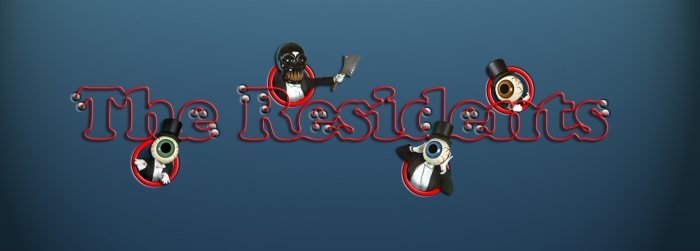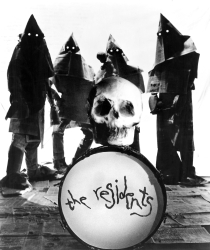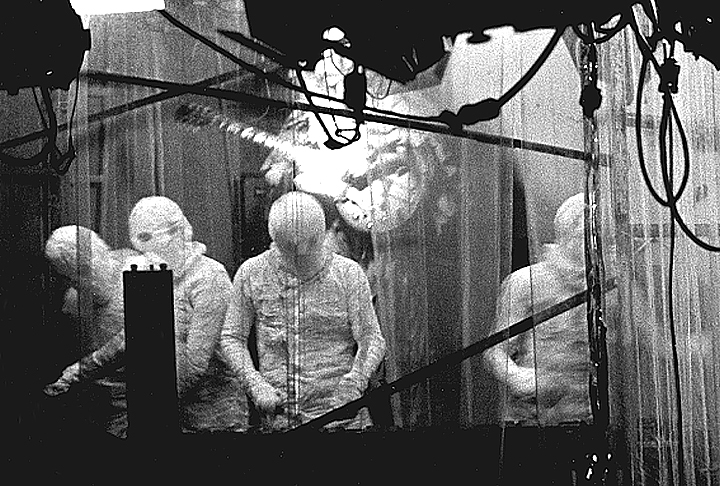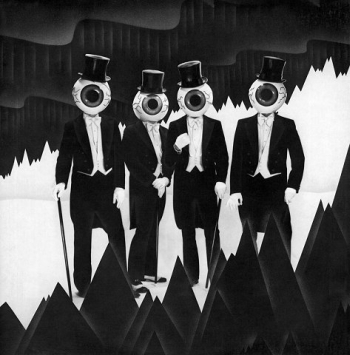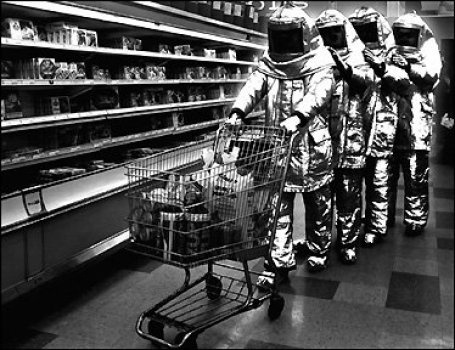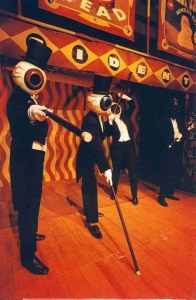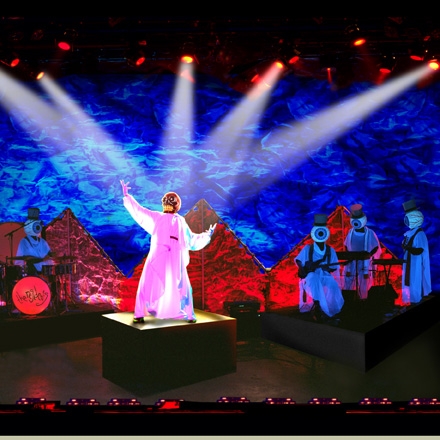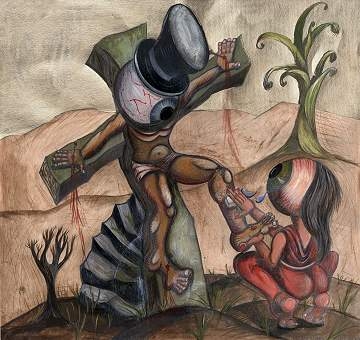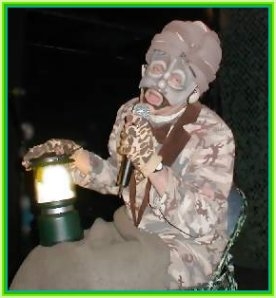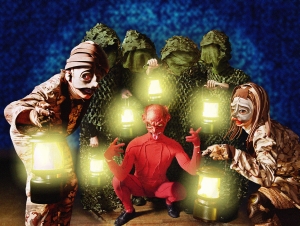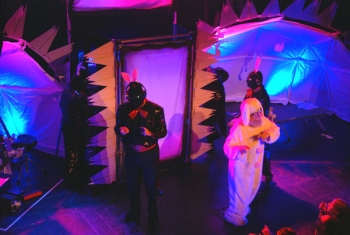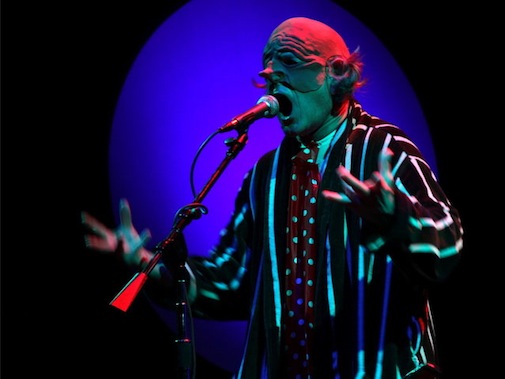|
The Residents – retrospective exhibition.
The Residents (San
Francisco) retrospective
exhibition is one of the most significant and at the same time one of
the most difficult and original projects that the Caesar Gallery has
ever organized. The project has been in preparation for several years
now and it is following an already finished video-retrospective that
took place in 2006 at Museum of Modern Art in New York. In cooperation
with the Mona Lisa Gallery,
there will be presented work of an American figurative paintress
and sculptress Leigh Barbier who´s been cooperating with The Residents for more
than 15 years.
The
Residents are,
in their area of activity, most important and most respected
anonymous music-art group overlapping to fine arts, performance, theater
and video art. The Residents are ranked
among the pioneers of video art and they became famous by their
experimental, and most of all innovative, approach to their unique music
records and experiments with new media.
The
Residents belong to world´s top groups, in spite of never making any
compromise towards commercial sphere. They are one of the most reputable
formations dealing with classical music, avant-garde and modern theater
art. Their unique live shows are mix of musical and visual sensation and
performance.
Works
of The Residents are represented in collections of e.g. Museum of Modern
Art (MoMA) in New York and Los Angeles Museum of Contemporary Art.
Their
works were presented e.g. at exhibitions at The
Museum of Contemporary Art - Los Angeles; The Kitchen - New York; Museum
of Modern Art - New York; Yerba Buena Center for the Arts - San
Francisco a Berkeley Art Museum.
Since the early
70s, The Residents, the
anti-stars, have been living on the edge of common awareness, but they
have become most important group and model for like-minded artists. All
their word is based on the principle of strict anonymity and mystique.
The Residents conceal their identity under various masks - one of the
most known is a famous mask in the form of the eyeball. Overlap in the
theater can be illustrated not only by the use of masks, but by puppets
and costumes they use in their performances as well.
Video
artists also react to creation of The Residents. They have been able to
use all possible media while creating their works. They have been always
one step ahead when it came to usage of new technologies. In cooperation
with The Voyager Company in 1994, they published very first interactive
CD-ROM called Freak Show,
which was based on the album and comics novel by the same name.
Within
the frame of the exhibition, a movie and video-clips retrospective will
take place (Videos by The
Residents 1975–2010). The exhibition will be complemented by
several original artifacts, graphic works, album concept art,
performance scenes, original photos, comics, masks and costumes.
This will be
the first time that The Residents´ creations and works are presented in
Europe in such a large scale.
HOMER
FLYNN BIO
Born in Shreveport, Louisiana in 1945, Homer Flynn
spent the first 24 years of his life submerged in the repressed, but
charming naivete of The South. Seduced by the fantasy of easy sex, cheap
drugs and loud music, Flynn was unwilling to commit to the life of a
concrete truck dispatcher attached to a pregnant, but unloved girlfriend
and fled to San Francisco in 1969. Guilty, but free, he drank deeply
from the cup of youth culture, ingesting, imbibing and fornicating any
and all.
Over the next 40 years, he was married twice, was
proud to be a partner in the propagation of two lovely daughters, Jana
and Isabelle, and became involved with the murky aesthetics of San
Francisco's music, performance and video group, The Residents. As their
chief visual designer and co-owner of The Cryptic Corporation, The
Residents' business and public relations interface, Flynn has been
involved in nearly all of the group's improbable projects since the
early 1970's. Currently, he lives in the Haight-Ashbury district of San
Francisco with his charming wife, Leigh Barbier.
Flynn also claims himself to be the inventor of the
shower-bath.
The
Art of The Residents:
How a Rock Band’s Look and Feel is Guided by the Hand of a
Faithful Craftsman, i.e., Homer Flynn
by George Petros
The
rock band known as The Residents consists of four anonymous individuals
wearing over their heads giant eyeballs, hiding secret identities
therein. Twisting pop music into playful abstractions since 1972,
they’ve blossomed into beloved avant-guardians of all that’s
bizarre. One should think and speak of them as a singular entity, an
unblinking collective eye that sees all.
Their
music draws upon jazz and Americana. In addition to home-made
compositions, they’ve tackled the work of George Gershwin, James
Brown, Hank Williams, and John Philip Sousa. They’ve sampled
Michael Jackson and John Cage. They complete that oft-cited trio of
spectacular sonic weirdos: Frank Zappa, Captain Beefheart, The
Residents.
But who are they? Who’s behind the eyeballs? Anonymity engenders
multiple layers of significance; not knowing who they are only makes
their music sound better. The Residents spare their fans the burden of a
personality cult — and relieve themselves of the spectacle of
being aging rock stars. The band professes, and practices, its own
“theory of obscurity.” No other rock act has embraced
anonymity as successfully. To this day, nobody knows who The Residents
really are.
They
assert responsibility for the first rock video (The Third Reich
’N Roll, 1975), the first use of consumer-level four-track
recording equipment for a rock release (Meet The Residents,
1974), first use of a TEAC stereo tape recorder for a rock release (Santa
Dog, 1972), first use of a sampler for a rock release (Tunes Of
Two Cities, 1982, on which they employed an E-mu Systems Emulator,
serial number 004), first MIDI recording of a rock release (God In
Three Persons, 1987), first interactive rock CD-ROM (Freak Show,
1994), and for being the first band to work under the aegis of their own
truly independent record label (Ralph Records, founded in 1972). Those
accomplishments only hint at their musical prowess: additionally, an
array of graphic firsts tops off their résumé. The Residents first
applied many now-familiar computer graphic programs to their videos,
album covers, and web site.
While
the musical sector of the Residential universe retains anonymity, the
art department is a different story. A real human being lurks behind the
graphics. Meet Homer Flynn, a friendly fellow from Shreveport,
Louisiana, who presides over the band’s various visual projects.
He’s worked with them since time immemorial. Flynn:
“Historically, I’ve done most of the graphics and visual
imagery for the group. In the day-to-day operation, I’m one of the
managers, babysitters, handlers — you know, communications
interfacer, whatever.”
Flynn was born April 11, 1945. His artistic experiences reflect a
folksy, unaffected attitude: “I’d studied some in college,
and had done a small amount of photography and commercial art, and was
just really interested in it all. I learned as I went along —
I had an inclination and an aptitude.” His poetic Southern accent
underscores a homespun heritage. Of his early association with the band,
he says, “Initially I did a lot of work helpin’ —
shall we say, slickin’ up things a little bit.
“I’m
pretty much self-taught. I operate based more on my limitations than
anything else. My work is based on what I like rather than on what
I’m influenced by. I was inspired by Fellini, M.C. Escher, Kurt
Vonnegut, John Steinbeck, Bo Diddley, and my parents.”
With charming humility he lauds his anonymous employers, side-stepping
his own indispensability: “They had a lot of rough ideas, and more
or less put things together; I kinda helped ’em, you know, create
a more professional realization of what it was they were doing.”
They — that unknowable collective entity at the heart of
Residency — are an unstoppable machine. Like B-movie mad
scientists they toil in secret studios, stressed out, too busy to eat,
their work always pressing them forward. One version of Homer Flynn sits
off to the side, a mere messenger waiting to deliver their next dispatch
to an impatient public. Another version of Homer taps a pointer on a
blackboard, and The Residents all come to attention; he addresses them
in urgent tech-speak, punctuating his talk with equations in chalk.
Still another Homer, oblivious, works a complicated gizmo of unknown
origin. He patiently processes everything. The invaluable link in the
chain, unappreciated and overlooked, he’s the real
flesh-’n-blood Homer who’s the human face of that collective
unknown, the all-encompassing “They” to whom paranoids and
Residents fans refer.
They concentrated on the music; Homer concentrated on packaging and
image. He founded Porno-Graphics, the design studio intimately
intertwined with the band. Of their anonymity he says, “The idea
was to have a different image with every product. If you look at the
stuff from the early 70s, you see the newspaper suits and radiation
suits and Santa Claus suits with funny-lookin’ eyes —
the idea was to do something different every time. Then when the
eyeballs came along in ’79, there was a new level of
sophistication. There was a general level of acceptance and interest in
this image from the public. It was a hit; people liked it. Of course,
the eyeballs cost a lot more money than taking a bunch of old newspapers
and folding them up into Ku Klux Klan suits.”
The eyeballs were Homer’s visionary gift to the world. He defers:
“It was the band’s idea. Like I said, they put it to me to
realize it. The eyeballs are solid spheres — the pupil in the
front is kind of like a little porthole with black mesh over it. A
problem was that visibility and hearing was limited. That made it really
difficult to perform. As the design became more sophisticated over the
years, the band had special performance eyeballs made out of plastic
mesh.
“The eyeballs they wear now were made by a professional mask-maker
in LA named Mark Siegel, who was working on Battlestar Galactica.
For The Residents’ 20th anniversary in ’92, we were invited
to go to Industrial Light & Magic and give a presentation of a
laserdisc we did for the Voyager company. Mark worked at ILM —
he was one of the top sculptors. He offered to make the eyeballs, as a
side project. The old ones were incredibly beat-up — they
really looked shitty and had been around the world several times.
“One was stolen from backstage at The Hollywood Palace, like
Christmas ’85. Supposedly a friend — quote-unquote —
took it, and another guy stole it from him and returned it a month or
two later. Nobody could figure out how it got out of the building —
it was not something you could put under your jacket. What happened was,
the first guy dropped it out of a window and picked it up when he left
the building. It had a crack in it. Our reaction was, ‘It’s
been on some interloper’s head — at this point
it’s cursed. There’ll never be another one.’ So,
I’d been working with these giant skulls. One of them got painted
black, and it replaced the lost-and-found eyeball — and that
Resident became in-mourning.”
The oversized, unblinking eyeball personifies The Residents’
razor-sharp vibe. Flynn: “They feel that they take the world in
and regurgitate it back out again. It’s their symbol of looking
back at the world.”
Perhaps what first put The Residents’ art on the map was their
1975 audio-visual masterpiece The Third Reich ’N Roll. Shot
with a 16mm Bolex, it looks like an outtake from Fritz Lang’s 1926
Sci-Fi classic Metropolis. After an introductory dance by atomic
shopping carts, a frantic band lays down a souped-up version of
something sounding like “Land of 1000 Dances.” They wear
newspapers folded into all-enshrouding costumes suggestive of the
KKK’s robes. Suddenly, alien-looking figures burst onto the scene,
killing the surprised band with lightning-spoutin’ weapons. Then,
dadaistic entities portray yet another rock band in a cavalcade of
stop-action antics climaxing in Hitlerian absurdity. Contrasting the
band’s happy energy, the death scenes are surprisingly convincing
in a photojournalistic way. A magnificent jumble of performance art,
schlock, and rock devolution, the video portended the enormously evolved
body of work that is now the band’s, and Homer’s, legacy.
Multi-media, improvisational, with lotsa subliminal unpleasantries —
it was all there, in grainy black and white. New York’s Museum of
Modern Art added The Third Reich ’N Roll to its permanent
collection. Homer Flynn, artist: “If you look at the video,
it’s a little world that we created and it’s very complete
in and of itself. We felt Psychedelia could stand to be progressed
further.” That seminal work best demonstrates why the all-seeing
ones — via Homer — rank with DEVO and Todd
Rundgren as pioneering rock-video artists.
Homer and the band shot many of their early videos on prehistoric
Panasonic and Sony half-inch, reel-to-reel, black-&-white video
camcorders — only just then available to consumers —
in a format called “industrial-quality.” They went on to
produce more and more videos, CD-ROMs, and DVDs, each embodying some new
facet of technology — and they’ll probably continue
pushing the envelope, becoming the first rock band to record with some
as-yet-unimagined molecular-level bio-electro marvel.
Musically speaking, Punk and New Wave swept them along, and they nestled
into an experimental, prog-rock niche, respected by pundits and
collectors. They scored some big-league stuff; for example, they did
music for ABC’s Pee Wee’s Playhouse (’87
through ’90), MTV’s The Big Picture (’92), Hunters:
The World of Predators and Prey for Discovery Channel (’98),
as well as Matchbox Toys’ TV commercials pushin’ Pee Wee
Action Figures (’88). The band never wavered from their commitment
to weirdness. Flynn: “We’ve always felt The Residents were
more marketable when understood to be on the fringe of the rock
world.”
They dwell on the fringe of the art world as well. Homer cut his chops
at the dawn of the digital age, when he mixed pixilated computer
printouts with photographs, photostats, typesetting, and xeroxes, as
well as with ink, paint, marker, and pictures lifted from magazines.
“It was a very wide-open time,” he recalls. “You had
to experiment to create new things, because the technology often just
wasn’t there, whereas now you can do anything you want in
Photoshop.
“You did stuff that’s experimental, and you got results back
that were sorta like, ‘Hmmm — it was an interesting
idea…’ You mixed ink, marker, dodging-and-burning in the
darkroom, a little airbrush here and there, spray paint, whatever.
“I never considered myself a really good photographer, but I was
really good at touch-up. I could airbrush or paint on a photo to get it
to look like whatever I wanted. When I got into Photoshop, I had ten
years’ darkroom experience to draw on. I loved it. Now I use a Mac
G3 with 750 megabytes of RAM, Photoshop 6, After Effects, and FreeHand.
“The Residents were usually the first to adapt the newest
consumer-level high-tech tools. They always like new toys. New
technology stimulates them in new directions and makes them think in
ways they haven’t thought in before.”
Of course, they — and he — got into computers from
the get-go. “The first thing we had in-house was an Apple ll —
but I didn’t particularly make friends with it,” he says.
“We had Commodore 64s and Ataris. I used a Koala Pad, a mouse that
was a drawing tablet marketed to kids. I often photographed images off
the monitor. When the Macs first came out, I was definitely seein’
the potential for artwork. In 1985 I did a cover for the single
“Kaw-liga” on a black-and-white Macintosh. I found a service
bureau that jerry-rigged a Lisa computer to be able to take the floppy
discs I was using and print them as, essentially, typesetting output.
For video I used a Mindset computer and the Koala Pad.”
Homer drew many of the band’s album covers. His renderings ranged
from the slickly airbrushed to the Flair-penned, and looked right at
home beside his photographic and computer-generated imagery. Asked about
recurring themes in his work, he replies, “The continuing
absurdity of life.”
The
band and their resident artist influenced lotsa high-profile
illustrators, designers, writers, and so on. Flynn: “The Residents
connect with the nerds and alienated people in every community.”
Eventually other artists joined in, under Homer’s loving aegis.
“More and more of it has become me collaborating with other
people, like Steven Cerio, Jim Ludtke, Gary Panter — who did
the imagery on the ads for Ralph Records’ ‘Buy or Die’
campaign — and Batman illustrator Brian Bolland, and
Charles Burns — who did the cover for our Freak Show
comic — and Georganne Deen…” The list goes on.
“People love working with The Residents because it allows them a
level of creative freedom that they just don’t really get all that
often.” Ultimately, however, Homer alone interacts with the
cornea’d ones; he guards their secrets, and keeps everyone out of
their inner sanctum. “The input comes from a lot of different
directions, but it pretty much all goes through me.”
No one who works with The Residents — and by default with
Homer Flynn — remains unfazed. Illustrator Steven Cerio, a
long-time Residential collaborator, expresses his love for them:
“The unblinking eyes of The Residents stand as a constant reminder
of the infinite possibilities of invention and
transcendence…they’re faceless, genderless, and void of
individual personalities — a brick pitched into the face of
mass marketing. They are a collective of unknown human quantities
shuttling along the cutting edge.”
In this brief space it’s impossible to summarize decades of
Homer’s, and the band’s, output. There’re over 25
albums, each of which sparked some sorta graphic extravaganza. Of their
countless videos, 17 are on Icky Flix, a DVD from East Side
Digital compiling their amazing amalgam of rock, paranoia, beauty,
Sci-fi, medical mayhem, and kids playing with knives. What appears on
the surface to be cute and silly reveals itself to be angry and deep.
Flynn: “It’s more a process of expression than an attempt to
create beauty, ugliness, sarcasm, or anything else.”
Among their remarkable visual accomplishments stands the interactive
CD-ROM Bad Day At The Midway (1996), a game set amidst a decrepit
carnival midway. It utilizes the expertise of animation guru Jim Ludtke,
an important Mac maestro who Beta-tested software from the beginning.
Ludtke gives the game a seamless beauty. Players manipulate a
baseball-capped kid creeping around an abandoned, partially-functioning
carnival midway. Marvelous freak-show facades glow in low-watted
splendor. The kid is spooked by endless rows of dummies, and by the
eerily-lit interior of a Victorian-era aquarium, and by the rat-driven
roulette wheel’s cheating croupier, and the roller coaster’s
smashed skeleton. An atomic mushroom cloud done in neon has to be seen
to be believed. A serial killer and an IRS agent lurk among the
ornaments, intent on derailing the kid. This revolutionary rock video
game features guest artists Leigh Barbier, Deen, and Cerio.
Many Residential video stills, posters, and photos, as well as the
band’s complete libretto, reside between the covers of Miroslav
Wanek and Karel Cisar’s Argo Press hardcover Eyeball To Eyeball.
Both English and Czech convey the lyrics to hundreds of songs (how about
this one: “Is obscurity itself the test tube of tomorrow?/Or is it
just the testing done to pave the way for sorrow?”). A
comprehensive listing of all their music, art, and performance projects
makes it the definitive Residents roundup circa its 1995 publication
date. For updated info, check out the website www.theresidents.com. One
can get most of the ocular ones’ music catalog on CDs from East
Side Digital.
In addition to being the Resident artist, Homer Flynn’s also the
official information interfacer for the band’s business persona,
The Cryptic Corporation. It’s his job to be cryptic: only he and
the elusive Hardy Fox, the “technical guy,” know who The
Residents really are. And so he must always deflect the curiosity of
others, or outright lie. His willowy Southern manner makes his
evasiveness enchanting. Any prodding after bandmembers’ identities
meets with platitudes like “The Residents don’t take
themselves that seriously, so they have a hard time understanding why
anyone else would.”
During an interview, this writer asks, “Is there a point in
Residents history where you eclipse them, or become the artistic center
of gravity?” Homer replies: “At least from a technical point
of view, that came pretty early. I’ve always had something to
offer to the process, otherwise I wouldn’t have been there.
‘Eclipsing’ is not so much the word I would use, as much as
I kinda took the art over and they trusted me to take it and run with
it. It’s never been my territory exclusively, because
they’ve always had veto power — which at times has been
used. They’ve always contributed ideas which I have
embraced.”
“So,” the questioning continues, “what should we call
you? I mean, are you — pardon the pun — the
resident art director?”
Homer: “Well, yeah. Visual facilitator. ‘Art director’
is certainly a term I have used a lot.”
Q: “What does your business card have on it?”
A: “Director. I’m one of the directors of the
corporation.”
Not bad for a guy who’s just lookin‘ to help out!
Year-round
programme of Galerie Caesar is supported by
Czech Ministry of
Culture and Olomouc
Region.


mediální partner / media partner

ZPĚT
|


